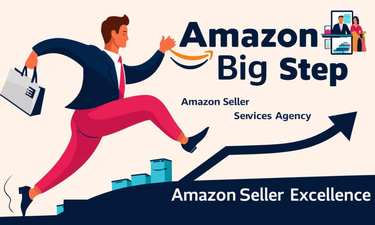Mastering Amazon A to Z: A Complete Guide for Sellers
Selling on Amazon is one of the most lucrative opportunities for eCommerce entrepreneurs. However, to succeed, sellers must navigate Amazon’s complex ecosystem, from product research and listing optimization to fulfillment, advertising, and customer service. This guide provides a comprehensive breakdown of Amazon’s A-to-Z process, ensuring you have all the knowledge needed to build and scale a successful Amazon business.
Amazon Big Step
5/8/20243 min read


1. Setting Up Your Amazon Seller Account
The first step in selling on Amazon is creating a Seller Central account. Amazon offers two types of seller accounts:
Individual Seller: Best for those selling fewer than 40 items per month, with a per-item fee instead of a subscription.
Professional Seller: Best for businesses selling more than 40 items per month, with access to advanced features like Amazon Ads and Buy Box eligibility.
Steps to Register as a Seller:
Sign up on Amazon Seller Central.
Provide your business details, tax information, and bank account.
Select your product categories and fulfillment method (FBA or FBM).
Set up your Amazon Storefront to showcase your brand.
2. Product Research & Amazon SEO Optimization
Successful sellers focus on high-demand, low-competition products. Amazon’s search algorithm ranks products based on relevance, sales history, and keyword optimization.
Tools for Product Research:
Helium 10: Helps identify profitable products with high search volume.
Jungle Scout: Offers data on product trends, competition, and demand.
Amazon Best Sellers & Movers & Shakers: Showcases trending products.
Amazon SEO Best Practices:
Use high-ranking keywords in your title, bullet points, and description.
Optimize backend search terms to improve visibility.
Focus on high-converting images and A+ Content (if enrolled in Brand Registry).
Encourage positive reviews to boost ranking and conversion.
3. Listing Optimization & A+ Content
Amazon product listings are the gateway to sales. Optimized listings drive conversions and improve organic ranking.
Essential Elements of a High-Performing Amazon Listing:
Title: Use primary keywords, brand name, and key product features.
Bullet Points: Highlight product benefits, features, and unique selling points.
Product Description: Expand on the product’s value, include relevant keywords, and answer customer FAQs.
High-Quality Images: Amazon recommends at least six high-resolution images, including lifestyle shots.
A+ Content: Available for brand-registered sellers, A+ Content enhances product pages with enhanced visuals and storytelling.
4. Choosing the Right Fulfillment Method (FBA vs. FBM)
Amazon sellers must decide between Fulfillment by Amazon (FBA) or Fulfillment by Merchant (FBM).
Amazon FBA (Fulfillment by Amazon):
✅ Amazon handles storage, shipping, and customer service. ✅ Prime eligibility, increasing customer trust and conversions. ✅ Faster shipping through Amazon’s fulfillment centers. ❌ Higher fees due to storage and fulfillment costs.
Amazon FBM (Fulfillment by Merchant):
✅ More control over packaging, shipping, and branding. ✅ Lower fees compared to FBA. ✅ Suitable for oversized or niche products. ❌ No automatic Prime eligibility.
5. Amazon PPC Advertising & Marketing Strategies
Amazon’s Pay-Per-Click (PPC) advertising system helps sellers increase visibility and drive sales.
Types of Amazon Ads:
Sponsored Products: Ads appear in search results and on product pages.
Sponsored Brands: Showcase multiple products and drive brand awareness.
Sponsored Display: Targets shoppers based on browsing behavior.
Amazon PPC Best Practices:
Perform keyword research to target high-volume, low-competition terms.
Monitor and optimize ACoS (Advertising Cost of Sale).
Use negative keywords to filter out irrelevant traffic.
Leverage Amazon DSP (Demand Side Platform) for retargeting customers.
6. Customer Service & Amazon A-to-Z Guarantee
Excellent customer service ensures high seller ratings and reduces negative feedback.
How to Handle Amazon’s A-to-Z Guarantee Claims:
Respond to customer inquiries within 24 hours to prevent disputes.
Provide tracking information and order updates.
Offer refunds or replacements when necessary.
Maintain a low Order Defect Rate (ODR) to avoid account suspension.
7. Handling Returns & Refunds on Amazon
Amazon has strict return and refund policies that sellers must comply with.
Key Return Policy Rules:
Amazon FBA handles returns automatically, while FBM sellers must manage their own.
Refunds should be issued within two business days upon receiving the returned item.
Ensure return labels and tracking numbers are properly managed.
8. Expanding Your Amazon Business & Global Selling
Once your business gains traction, scaling up is the next step. Amazon offers multiple opportunities for growth:
Scaling Strategies:
Amazon Brand Registry: Protects your brand and provides access to advanced marketing tools.
Amazon Global Selling: Expands your store to international marketplaces (Europe, Canada, Asia, etc.).
Amazon Wholesale & Private Labeling: Differentiates your business with unique, high-margin products.
Amazon Subscription & Subscribe & Save: Encourages repeat purchases and customer retention.
9. Analyzing Performance & Using Amazon Reports
Tracking key performance metrics ensures continuous improvement.
Essential Amazon Analytics Tools:
Amazon Business Reports: Tracks sales trends and conversion rates.
Amazon Brand Analytics: Provides insights into competitor performance and customer behavior.
Inventory Performance Dashboard: Helps manage stock levels and avoid storage penalties.
10. Common Amazon Seller Mistakes to Avoid
Many new sellers make critical mistakes that hinder growth. Avoid these pitfalls:
Not optimizing product listings with the right keywords and descriptions.
Ignoring Amazon’s performance metrics, leading to account suspension risks.
Failing to manage inventory properly, causing stockouts or excessive storage fees.
Neglecting customer service, resulting in poor seller ratings and lost sales.
Relying solely on organic traffic without leveraging Amazon PPC ads.
Final Thoughts
Mastering Amazon A to Z requires a deep understanding of its processes, from setting up an account and conducting product research to optimizing listings, handling fulfillment, and running effective advertising campaigns. By leveraging Amazon FBA, optimizing product pages with high-ranking keywords, and using Amazon PPC efficiently, sellers can build a profitable and scalable eCommerce business on the world’s largest marketplace.
With continuous learning, strategic execution, and adaptation to Amazon’s evolving landscape, sellers can achieve long-term success and maximize their earning potential on Amazon.
Are you ready to take your Amazon business to the next level? Start optimizing today and dominate the marketplace!
Expertise
Your partner for Amazon growth and success.
Services
Insights
connect@amazonbigstep.com
+1 (859)4182348
© 2025. All rights reserved.
